Crohn's disease
Crohn’s Disease (CD) is one of the two main forms of Inflammatory Bowel Disease (IBD).
CD can affect any part of the gut, but is most likely to develop in the ileum (the last part of the small intestine) or the colon. The areas of inflammation are often patchy, with sections of normal gut in between. A patch of inflammation may be small, only a few centimeters across, or extend quite a distance along part of the gut. As well as affecting the lining of the bowel, CD may also penetrate deeper into the bowel wall causing abscesses and fistulas (abnormal tracts or passages between organs such as between two sections of bowel, or the bowel and skin).
WHAT ARE THE SYMPTOMS?
CD may range from mild to severe, and will vary from person to person. Please refer to Clinical Presentation for the list of the most common symptoms.
WHAT ARE THE DIFFERENT TYPES OF CROHN’S DISEASE?
Crohn’s is often categorized according to which part or parts of the gut are most affected. Sometimes it can affect more than one part of the gut. The main types are as follows:
Terminal ileal and ileocaecal
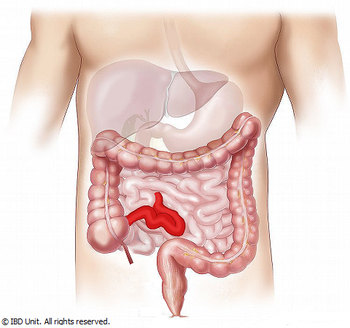
Crohn’s in the ileum (the last part of the small intestine) may be called ileal or sometimes ‘terminal ileal’ Crohn’s – because it is affecting the terminus or end of the ileum. If it also affects the beginning of the large bowel it is known as ileocecal Crohn’s.
This is one of the most common forms of CD. Typical symptoms are the pain in the lower right side of the abdomen, especially after eating, diarrhea and weight loss. Any bleeding is unlikely to be visible in stools, but stools may appear black and blood tests may show that you are anemic.
Colonic
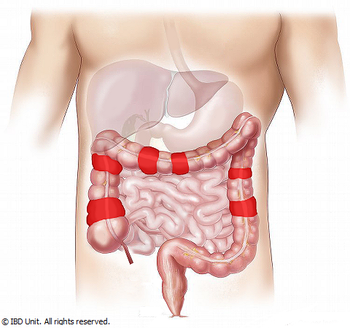
Crohn’s Disease in the colon (large intestine or large bowel) is often called Crohn’s Colitis.
This is also a common form of CD, but is not the same as Ulcerative Colitis. The main symptom tends to be diarrhea, with blood and mucus. Because of the inflammation, the colon cannot hold as much waste as normal and you may have very frequent bowel movements, especially if your rectum is inflamed. You may also have urgency to pass stools, and tenesmus (feeling the need to pass a stool although the rectum is empty).
If Crohn’s disease affects both ileum and colon, it is called Crohn's ileocolitis.
Small bowel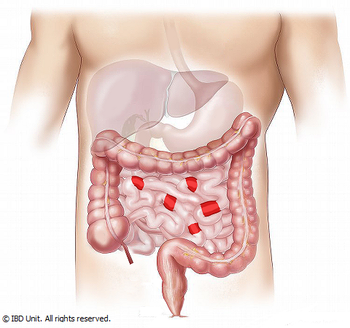
This type of Crohn’s is also referred to as ileitis or jejunoileitis, depending on the part of the small bowel affected. Abdominal pain and diarrhea are also typical symptoms of Crohn’s in the small bowel, along with nutrient deficiencies. Again, the diarrhea is unlikely to be blood-stained, but you may still have anemia, and also weight loss. The small bowel is commonly affected in children and young people.
Perianal
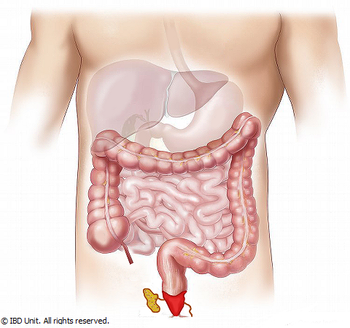
Crohn’s in the area around the anus (back passage) can occur on its own or at the same time as inflammation in other parts of the body. It is quite common, and some people notice perianal symptoms before they develop intestinal symptoms. It causes a number of symptoms, such as:
-
Fissures – these are tears or splits in the lining of the anal canal (back passage), which can cause pain and bleeding, especially during bowel movements
-
Skin tags – small fleshy growths around the anus
-
Hemorrhoids (piles) – swollen blood vessels in or around the anus and rectum
-
Abscesses – collections of pus that can become swollen and painful. They are often found in the area around the anus and can cause a fever or lead to a fistula.
-
Fistulas – these are narrow tunnels or passageways between the gut and the skin or another organ.
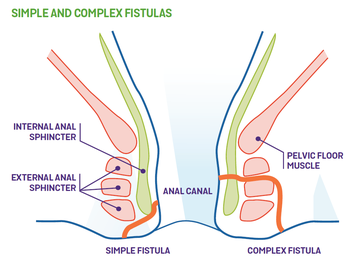 In perianal Crohn’s, fistulas often run from the anal canal to the skin around the anus. They appear as tiny openings in the skin that leak pus or sometimes fecal matter. They can irritate the skin and are often sore and painful, but can usually be treated with medication and/ or surgery. For more information see Living with a Fistula.
In perianal Crohn’s, fistulas often run from the anal canal to the skin around the anus. They appear as tiny openings in the skin that leak pus or sometimes fecal matter. They can irritate the skin and are often sore and painful, but can usually be treated with medication and/ or surgery. For more information see Living with a Fistula.
Gastroduodenal
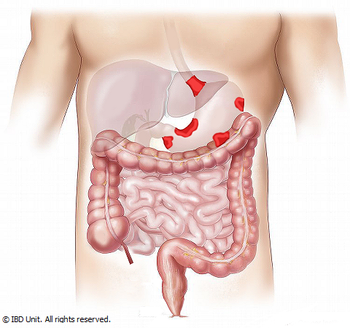
Crohn’s in the upper gut – the esophagus, stomach or duodenum – is much less common, but may occur on its own or alongside Crohn’s in other parts of the digestive system. Key symptoms include indigestion-like pain, nausea with or without vomiting, loss of appetite, and weight loss and anemia.
Oral Crohn’s
Crohn’s can occasionally affect the mouth. True oral Crohn’s, is often referred to as ‘orofacial granulomatosis’ and is more likely to affect children, although it is rare. It typically causes swollen lips and mouth fissures. Some people with Crohn’s may develop mouth ulcers during flare-ups. This can sometimes be due to nutritional deficiencies such as vitamin B12, folate, and iron.
CAN CROHN’S HAVE COMPLICATIONS WITHIN THE BOWEL?
Crohn’s can sometimes cause complications (extra problems). These may be in the gut itself or can involve other parts of the body. Complications in the gut may include strictures, perforations, and fistulas.
Strictures
Ongoing inflammation and then healing in the bowel may cause scar tissue to form, which can create a narrow section of the bowel. This is known as a stricture. A stricture can make it difficult for food to pass through and, if severe, may cause a blockage (obstruction). Symptoms include severe cramping abdominal pain, nausea, vomiting and constipation. The abdomen may become bloated and distended, and the gut may make loud noises. Strictures are usually treated surgically, often with an operation known as a stricturoplasty. However, in some cases it may be possible to treat them endoscopically with balloon dilatation (see What are the most likely operations for Crohn’s Disease). Some people have ‘inflammatory strictures’, where inflammation, not scar tissue, narrows the intestines. Often, medication can reduce this inflammation.
Perforations
Although rare, inflammation deep in the bowel wall or a severe blockage caused by a stricture may lead to a perforation or rupture of the bowel, making a
hole. The contents of the bowel can leak through the hole. This complication is a medical emergency. Symptoms include severe abdominal pain, fever, nausea, and vomiting. In some cases, the leak will form an abscess.
Fistulas
Some people with Crohn’s may develop a fistula. A fistula is an abnormal channel or passageway connecting one internal organ to another, or to the outside surface of the body. Most fistulas (also called fistulae) start in the wall of the intestine and might connect parts of the bowel to each other, or the bowel to the vagina, bladder, or skin (particularly around the anus). A fistula forms when the inflammation in Crohn’s spreads through the whole thickness of the bowel wall and then continues to tunnel through the layers of other tissues. Fistulas may be treated medically or with surgery. For more details see Living with a Fistula.
CAN CROHN'S DISEASE AFFECT OTHER PARTS OF THE BODY?
Crohn's disease (CD) can cause complications (extra problems) outside the digestive system. Over a third of people with CD develop other conditions, mainly affecting the joints, eyes and skin. Refer to the Extraintestinal Manifestations section for more information.
You may find helpful information available in the IBD diagnostics, IBD treatment and IBD and lifestyle sections.









